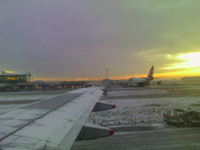First day of the new-year and I went out on a guided walk through the bush with http://www.bluemountainswalkabout.com
The original Aboriginal clan from this area was rapidly wiped out with the arrival of European settlers and the smallpox that arrived with them, but our guide Evan Yanna Muru has worked as an Aboriginal Discovery Ranger, going out into the bush searching for ancient sites and the song-lines that connect them.
The walkabout is a right of passage to the Aboriginal people, a rebirth from one part of your life to the next where the initiates would be taught the stories that impart the rules and traditions of the clan, so the start of the new-year seemed a very appropriate time to take this journey.
We left Faulconbridge railway station at 10:45 and a few minutes later stepped off the path and into the bush. With a guide it was very easy to see the trail we were following, but on your own I doubt that you would be able to find the route for yourself or recognise it as anything other than an animal run.
The start of our journey came with our first taste of bush tucker, a sweet violet berry growing by the side of the trail.
As we went along Evan pointed out plant and their uses, a tree with black bark that can be used to cover wounds, the bark having anti-septic properties, and the gum from another tree that would be used to stick the bark to your skin – the gum itself having anti-septic and pain relieving properties.
With the Aboriginal lifestyle, it was important (and reinforced with their rituals) to leave all negetivity behind and be at one with the land, to feel the energies of the rainbow serpent all around and within yourself, to listen to those energies and let them guide you. There were some harsh punishments for those rare clan members who couldn’t release themselves from negitivity.
Being at one with the land was the theme of the first spiritual site we visited, an ancient rock carving depicting a wallaby who ignores this message and concentrates on something in the bush, with her awareness focused, she doesn’t see that the rainbow serpent has stalked her young joey and taken it away.
Our second stop was an amazing sandstone cave, where the bones of the earth, surreal natural rock formations, were exposed. At thes stop Evan showed us some of the leaves that could be crushed, roled and placed up each nostril to allow the menthol vapours to clear your breathing, and also the tea tree leaves the oil of which has a huge variety of uses.
The walk so far had been accompanied by the shrill calls of cicadas, especially noisy this year, in ancient times this increase of numbers and the food source it provided would have prompted a great corroboree, a large meeting uniting various clans to exchange songs, perform ritual dances, have ceremonial battles, arrange marriages and suchlike.
As we descended into the rainforest, we left this cacophony behind and after a long challenging section arrive at our spot for lunch, a sheltered billabong under a waterfall. Evan explained to us the sybolism used in Aboriginal art and how to grind ocres to make paints for traditional art, giving us chance to experiment on park and leaves that we had collected on our journey.
After lunch we started the more strenuous ascent out of the valley we had come down in the morning. As we re-entered the realm of the cicadas, we came to the final site of the tour a rock cave featuring handprints from ancient Aboriginies including one from a “clever man” (spiritual doctor) recognisable as it also shows his arm. Whereas women would complete 5 rituals during their lives and men 10, the cever men would complete 15 walkabouts, some taking over a year and covering great distances, their apprenticeship could take up to 30 years.


























































